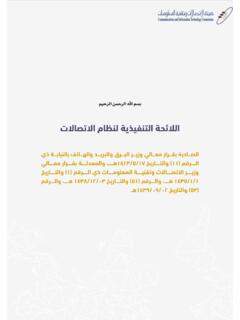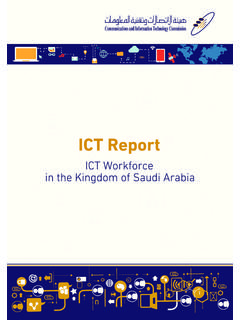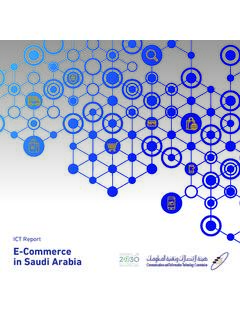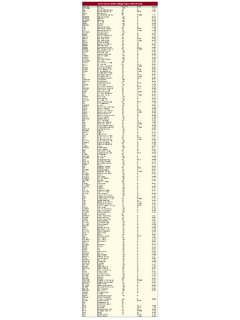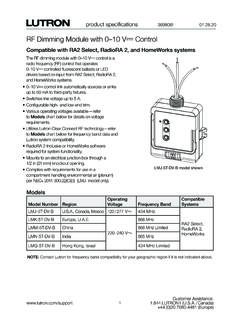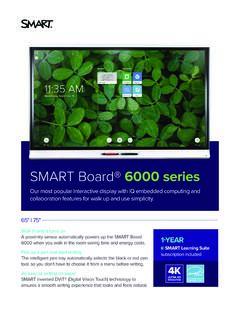Transcription of DRAFT REGULATORY FRAMEWORK ON INTERNET OF ... - …
1 Kingdom of Saudi Arabia DRAFT REGULATORY FRAMEWORK ON INTERNET OF THINGS (IoT) February 2019 DRAFT REGULATORY FRAMEWORK ON INTERNET OF THINGS (IoT) 2 Contents 1. INTRODUCTION .. 3 2. DEFINITIONS .. 4 3. IoT Service Provisioning .. 4 4. Spectrum .. 5 5. IoT Equipment .. 6 6. IoT Identifiers .. 6 7. Data Management .. 6 8. IoT Mission Critical Services .. 7 9. GENERAL REGULATIONS .. 7 DRAFT REGULATORY FRAMEWORK ON INTERNET OF THINGS (IoT) 3 1. INTRODUCTION The Communications and Information Technology Commission (CITC) is mandated, in accordance with the Telecommunications Act, Telecom Act Bylaw and CITC Ordinance; to regulate the telecommunications and IT sector in the Kingdom, this includes service provisioning, device licenses and spectrum.
2 One of the most important services that CITC works to ensure its availability in the Kingdom is INTERNET of Things (IoT) services. INTERNET of Things (IoT) refers to enabling large number of virtual and physical things to connect to the INTERNET as well as tocollect and exchange data with each other. IoT services can be used in various sectors such as education, health, agriculture, utility and transportation. The International Telecommunication Union (ITU) defines IoT as: "A global infrastructure for the information society, enabling advanced services by interconnecting (physical and virtual) things based on existing and evolving interoperable information and communication technologies". "Things" can be any virtual or physical objects that can be identified and communicate with each other.
3 Machine- to- Machine (M2M) enables the communications between two or more machines without human interactions. Examples of M2M includes point of sales and ATM machines. For the purpose of this document, IoT will be used to cover M2M. Based on its role in enabling ICT technologies and in order to achieve the Kingdom Vision 2030, CITC is targeting enabling IoT implementations in the Kingdom on a wide range with the envision of making the Kingdom a leading country in developing of IoT services. Thus, the CITC published this document to regulate all IoT services and use cases. 2. DEFINITIONS The words and expressions defined in the CITC regulations shall have the same meaning when used in this REGULATORY FRAMEWORK . The following words and expressions shall have the meaning assigned to them below.
4 INTERNET of Things (IoT): Global infrastructure for the information society, enabling advanced services by interconnecting (physical and virtual) things based on existing and evolving interoperable information and communication technologies . License- Exempt Frequency: frequency or frequency bands that can be used on shared basis without a license from the CITC, and in accordance with the conditions it defines for such usage. As per the ITU definition. DRAFT REGULATORY FRAMEWORK ON INTERNET OF THINGS (IoT) 4 Things: Physical and virtual objects that are capable of being identified and communicated with each other. License- Exempt IoT Services: IoT services provided through LPWAN using license- exempt frequencies.
5 LPWAN: (Low Power Wide Area Networks) wireless wide area network technologies that interconnect low bandwidth, battery powered devices with low bit rates. IoT Mission Critical Services: IoT services that if fail, may result in serious impact on heath, public safety, resources or national security. Indoor: Areas located within personal premises (Houses, private compounds, etc). Outdoor: Areas located outside of personal premises, where the radio waves of these wireless networks are propagating (streets, public areas, parks, etc). CITC: Communications and Information Technology Commission. 3. IoT Service Provisioning IoT services can be provided using wired and wireless networks. They can be classified according to the networks used into: IoT services provided through mobile networks, IoT services provided through satellite and IoT services provided using license- exempt frequencies.
6 The main requirements for providing IoT services are as follow: A. IoT services through mobile networks can be provided by licensed service providers from the CITC, such as Facilities Based Unified Licensees, MVNOs, IoT- VNOs, or any other licenses defined by CITC. The conditions and commitments for the above licenses are available through the CITC website ( ). B. IoT services using satellite can be provided through service providers licensed by CITC to provide satellite communications services. C. For IoT services using license- exempt frequencies: o IoT services using license- exempt frequencies can be provided commercially by service providers that have "providing IoT services using license- exempt frequencies" license from CITC. This Class B license and the REGULATORY FRAMEWORK on INTERNET of Things include all the commitments and requirements that the licensed service providers must commit with.
7 O Service providers having the Facilities Based Unified License from the CITC can provide this type of services without the condition of having "providing IoT services using license- exempt frequencies" license from CITC. DRAFT REGULATORY FRAMEWORK ON INTERNET OF THINGS (IoT) 5 o IoT networks that use license- exempt frequencies can be built and used indoor for non-commercial purposes without the condition of having "providing IoT services using license- exempt frequencies" license from CITC. However, the requirements related to data security and privacy that are included in this document as well as the condition of complying the equipment with the CITC Technical Specifications must be met.
8 O IoT networks that use license- exempt frequencies can only be built outdoor by licensees having "providing IoT services using license- exempt frequencies" license from CITC, or service providers that have the Facilities Based Unified License from the CITC. 4. Spectrum Frequency bands for mobile networks and satellite communications are included in the related Technical Specifications published on the CITC website ( ). These frequency bands are assigned according to the procedures defined by the CITC. Frequency bands that can be used for license- exempt LPWANs are shown in Annex 1 of this document . The CITC Technical Specifications numbered (RI114) includes all the technical details for the equipment used in these networks. It is important to note here that the license- exempt LPWANs use shared spectrum with other users, and accordingly the CITC does not protect the users of these networks from the interference that might result from any other source.
9 Additionally, the users of the license- exempt LPWANs do not have the rights to ask for protection from interference resulted from the main users. 5. IoT Equipment The following requirements must be complied with regarding IoT equipment: All equipment must comply with the Technical Specifications published on the CITC website ( ) with regard to radio, EMC and safety. For license- exempt LPWAN equipment, they must comply with the Technical Specifications numbered (RI114). In case an IoT equipment is restricted, then it must be approved by CITC and has Certificate of Conformity before applying for Customs Clearance permission. The Equipment Approval and Customs Clearance requirements and procedures are detailed in the "Regulations for Importation and Licensing of Telecommunications and Information Technology Equipment" document which is published on the CITC website ( ).
10 DRAFT REGULATORY FRAMEWORK ON INTERNET OF THINGS (IoT) 6 Since there are different IoT technologies and standards, the interoperability between IoT networks and equipment must be considered by the user and the service provider so that any user can transfer and use his equipment among service providers using the same type of technologies and frequency bands. The IoT equipment shall have the capability of reset to the factory settings. 6. IoT Identifiers An identifier is a group of numbers or symbols that uniquely identify an object to simplify the communications with. Communication identifiers are used to identify end points (source, destination). Currently, the most common communication identifiers used in IoT are numbers and IP addresses.
